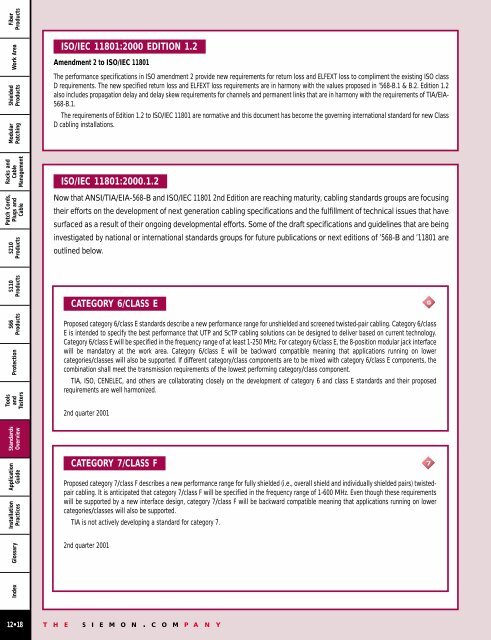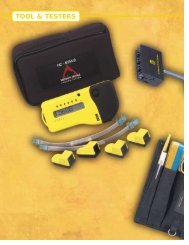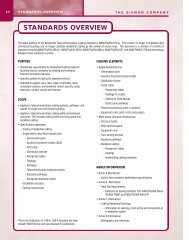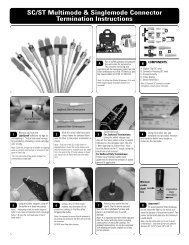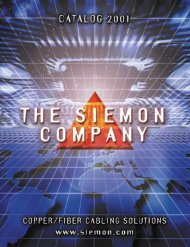- Page 2 and 3:
You must welcome change as the rule
- Page 5:
Product Innovation The Siemon Compa
- Page 9:
Commercial - Industrial BASF BEIJIN
- Page 12 and 13:
Fiber Products Work Area FIBER PROD
- Page 14 and 15:
Index Work Area Shielded Products T
- Page 16 and 17:
Index Glossary Work Area Racks and
- Page 18 and 19:
Fiber Products Work Area RACK MOUNT
- Page 20 and 21:
Fiber Products Work Area WALL MOUNT
- Page 22 and 23:
Work Area Racks and Cable Managemen
- Page 24 and 25:
Installation Practices S66 Products
- Page 26 and 27:
Index Work Area Shielded Products M
- Page 28 and 29:
Work Area Shielded Products S66 Pro
- Page 30 and 31:
Work Area S210 Products Protection
- Page 32 and 33:
Fiber Products Work Area WORK AREA
- Page 34 and 35:
Fiber Products Work Area CT ® 6 CO
- Page 36 and 37:
Work Area Shielded Products Tools a
- Page 38 and 39:
Work Area Shielded Products Tools a
- Page 40 and 41:
Work Area Index Shielded Products T
- Page 42 and 43:
S110 Products Work Area Shielded Pr
- Page 44 and 45:
Work Area Modular Patching Racks an
- Page 46 and 47:
Fiber Products Work Area MAX 6 MOD
- Page 48 and 49:
Work Area Shielded Products Modular
- Page 50 and 51:
Tools and Testers Fiber Products Wo
- Page 52 and 53:
Index Modular Patching Fiber Produc
- Page 54 and 55:
Work Area Tools and Testers Modular
- Page 56 and 57:
Work Area Shielded Products Modular
- Page 58 and 59:
Glossary Work Area Shielded Product
- Page 60 and 61:
Work Area Racks and Cable Managemen
- Page 62 and 63:
Work Area Glossary Tools and Tester
- Page 64 and 65:
Work Area Racks and Cable Managemen
- Page 66 and 67:
Work Area Shielded Products Protect
- Page 68 and 69:
Work Area Shielded Products S66 Pro
- Page 70 and 71:
Tools and Testers S110 Products Rac
- Page 72 and 73:
Fiber Products Work Area SCREENED A
- Page 74 and 75:
Work Area TERA S110 Products Racks
- Page 76 and 77:
Fiber Products Work Area Shielded P
- Page 78 and 79:
Work Area Shielded Products Modular
- Page 80 and 81:
Fiber Products Work Area MODULAR PA
- Page 82 and 83:
Fiber Products Work Area HD6 PATCH
- Page 84 and 85:
Work Area Shielded Products Tools a
- Page 86 and 87:
Index Work Area Tools and Testers S
- Page 88 and 89:
Index Work Area Tools and Testers S
- Page 90 and 91:
Work Area Shielded Products Fiber P
- Page 92 and 93:
Fiber Products Work Area RACKS AND
- Page 94 and 95:
Work Area Shielded Products Glossar
- Page 96 and 97:
Index Work Area Shielded Products G
- Page 98 and 99:
Work Area Index Glossary Shielded P
- Page 100 and 101:
Work Area Shielded Products Fiber P
- Page 102 and 103:
Work Area Shielded Products Modular
- Page 104 and 105:
Work Area Shielded Products Index R
- Page 106 and 107:
Fiber Products Work Area PATCH CORD
- Page 108 and 109:
Fiber Products Work Area MC6 MODUL
- Page 110 and 111:
Racks and Cable Management Fiber Pr
- Page 112 and 113:
Work Area Shielded Products Modular
- Page 114 and 115:
Work Area Shielded Products Modular
- Page 116 and 117:
Tools and Testers Fiber Products Wo
- Page 118 and 119:
Fiber Products Work Area S210 ® PR
- Page 120 and 121:
Fiber Products Work Area S210 ® CO
- Page 122 and 123:
Work Area Shielded Products Racks a
- Page 124 and 125:
Work Area Index Tools and Testers S
- Page 126 and 127:
Index S110 Products Racks and Cable
- Page 128 and 129:
Fiber Products Work Area S110 ® PR
- Page 130 and 131:
Glossary Work Area Tools and Tester
- Page 132 and 133:
Glossary Work Area Shielded Product
- Page 134 and 135:
Work Area Shielded Products Index G
- Page 136 and 137:
Work Area Glossary Tools and Tester
- Page 138 and 139:
Index Glossary Work Area Tools and
- Page 140 and 141:
Installation Practices S210 Product
- Page 142 and 143:
Index Glossary Work Area Shielded P
- Page 144 and 145:
Index S110 Products Racks and Cable
- Page 146 and 147:
Work Area Shielded Products Fiber P
- Page 148 and 149:
Work Area Shielded Products Racks a
- Page 150 and 151:
S110 Products S210 Products Work Ar
- Page 152 and 153:
Fiber Products Work Area S66 PRODU
- Page 154 and 155: Fiber Products Work Area S66M1-50 B
- Page 156 and 157: Work Area Glossary Tools and Tester
- Page 158 and 159: Work Area Fiber Products Shielded P
- Page 160 and 161: Index Work Area Shielded Products G
- Page 162 and 163: S210 Products Shielded Products Fib
- Page 164 and 165: Work Area Shielded Products Modular
- Page 166 and 167: Tools and Testers Fiber Products Wo
- Page 168 and 169: Fiber Products Work Area Shielded P
- Page 170 and 171: Work Area Index Tools and Testers S
- Page 172 and 173: Work Area Index Shielded Products M
- Page 174 and 175: Fiber Products Work Area Shielded P
- Page 176 and 177: Index Work Area Glossary Tools and
- Page 178 and 179: Work Area Shielded Products Fiber P
- Page 180 and 181: Work Area Shielded Products Modular
- Page 182 and 183: Work Area Shielded Products Applica
- Page 184 and 185: Glossary Work Area Shielded Product
- Page 186 and 187: Index Work Area Shielded Products M
- Page 188 and 189: Glossary S66 Products Fiber Product
- Page 190 and 191: Work Area Shielded Products Index M
- Page 192 and 193: Work Area Shielded Products Modular
- Page 194 and 195: Work Area Shielded Products Modular
- Page 196 and 197: Index Work Area Installation Practi
- Page 198 and 199: Work Area Racks and Cable Managemen
- Page 200 and 201: Index Standards Overview Modular Pa
- Page 202 and 203: Work Area Shielded Products Modular
- Page 206 and 207: Index Shielded Products Fiber Produ
- Page 208 and 209: Work Area Fiber Products Shielded P
- Page 210 and 211: Work Area Shielded Products Modular
- Page 212 and 213: Work Area Shielded Products Modular
- Page 214 and 215: Index Work Area Installation Practi
- Page 216 and 217: Work Area Shielded Products Modular
- Page 218 and 219: Fiber Products Work Area Shielded P
- Page 220 and 221: Standards Overview Work Area Shield
- Page 222 and 223: Work Area Standards Overview Tools
- Page 224 and 225: Work Area Shielded Products Standar
- Page 226 and 227: Work Area Shielded Products Standar
- Page 228 and 229: Work Area Shielded Products Tools a
- Page 230 and 231: Work Area Shielded Products Standar
- Page 232 and 233: Fiber Products Work Area Index Shie
- Page 234 and 235: Index Work Area Racks and Cable Man
- Page 236 and 237: Index Work Area Glossary Standards
- Page 238 and 239: Index Work Area Standards Overview
- Page 240 and 241: Index Application Guide Standards O
- Page 242 and 243: Work Area S210 Products Shielded Pr
- Page 244 and 245: Application Guide Standards Overvie
- Page 246 and 247: Work Area Shielded Products Modular
- Page 248 and 249: Work Area Shielded Products Modular
- Page 250 and 251: Work Area Shielded Products Modular
- Page 252 and 253: Work Area Shielded Products Modular
- Page 254 and 255:
Work Area Shielded Products Modular
- Page 256 and 257:
Work Area Shielded Products Modular
- Page 258 and 259:
Work Area Shielded Products Modular
- Page 260 and 261:
Index Glossary Installation Practic
- Page 262 and 263:
CATALOG PART NUMBER DESCRIPTION QTY
- Page 264 and 265:
product spec sheets technical artic
- Page 266 and 267:
MT-RJ JUMPERS INSTALLATION INSTRUCT
- Page 268 and 269:
LC PRODUCTS SPECIFICATION SHEET RET
- Page 270 and 271:
LC JUMPERS SPECIFICATION SHEET RETU
- Page 272 and 273:
RACK MOUNT INTERCONNECT CENTER (RIC
- Page 274 and 275:
WALL MOUNT INTERCONNECT CENTER (SWI
- Page 276 and 277:
FIBER CONNECT PANEL (FCP3) INSTALLA
- Page 278 and 279:
SPLICE TRAYS RETURN
- Page 280 and 281:
PLUG AND PLAY MODULES SPECIFICATION
- Page 282 and 283:
ST AND SC FIBER CABLE ASSEMBLIES IN
- Page 284 and 285:
AUTOMATED FIBER POLISHER INSTALLATI
- Page 286 and 287:
LC FIBER TERMINATION UPGRADE KIT SP
- Page 288 and 289:
ANGLED CT ® 6 COUPLERS INSTALLATIO
- Page 290 and 291:
CT ® 5e COUPLERS SPECIFICATION SHE
- Page 292 and 293:
STAINLESS STEEL CT ® FACEPLATES LA
- Page 294 and 295:
CT ® SERVICE FITTING PLATES RETURN
- Page 296 and 297:
STAND-OFF RINGS RETURN
- Page 298 and 299:
BRITISH CT ® FACEPLATES LABELING T
- Page 300 and 301:
INTERNATIONAL CT ® FACEPLATES LABE
- Page 302 and 303:
MAX 6 MODULES SPECIFICATION SHEET
- Page 304 and 305:
FLAT MAX 6 MODULES INSTALLATION IN
- Page 306 and 307:
MAX 5e PUNCH-DOWN SPECIFICATION SH
- Page 308 and 309:
MAX 3 MODULES INSTALLATION INSTRUC
- Page 310 and 311:
COAX MAX MODULES RETURN
- Page 312 and 313:
MAX OUTLET BLANKS & DOORS RETURN
- Page 314 and 315:
MAX MODULAR FACEPLATES LABELING TE
- Page 316 and 317:
MAX DUPLEX AND DESIGNER FACEPLATE
- Page 318 and 319:
MAX MODULAR FURNITURE ADAPTERS INS
- Page 320 and 321:
MAX BRISTISH FLEXYOKES INSTALLATIO
- Page 322 and 323:
MAX INTERNATIONAL ADAPTERS RETURN
- Page 324 and 325:
MAX MUTOA INSTALLATION INSTRUCTION
- Page 326 and 327:
FIBER OUTLET BOX INSTALLATION INSTR
- Page 328 and 329:
SM ® SURFACE MOUNT BOXES INSTALLAT
- Page 330 and 331:
CATEGORY 5e FACTORY ASSEMBLED SM ®
- Page 332 and 333:
SM ® MODULAR JACK COMPONENTS SPECI
- Page 334 and 335:
SM ® COAX ADAPTER BEZELS SPECIFICA
- Page 336 and 337:
6-PORT SP5 SURFACE PACK MODULE INS
- Page 338 and 339:
PERIMETERS EXTRUSIONS SPECIFICATIO
- Page 340 and 341:
TERA SPECIFICATION SHEET RETURN
- Page 342 and 343:
TERA 4-PAIR PLUGS INSTALLATION INS
- Page 344 and 345:
TERA 1-PAIR UTP PLUG SPECIFICATION
- Page 346 and 347:
PCB TERA OUTLET SPECIFICATION SHEE
- Page 348 and 349:
TERA -MAX PATCH PANELS INSTALLATI
- Page 350 and 351:
SCREENED CT ® 6 COUPLERS INSTALLAT
- Page 352 and 353:
HD5 ® SCREENED PATCH PANELS INSTAL
- Page 354 and 355:
HD6 PATCH PANELS INSTALLATION INST
- Page 356 and 357:
OPTIONAL ACCESSORIES RETURN
- Page 358 and 359:
12-PORT HD5 ® MOUNTED ON S89D BRAC
- Page 360 and 361:
MAX PATCH PANELS INSTALLATION INST
- Page 362 and 363:
OPTIONAL ACCESSORIES RETURN
- Page 364 and 365:
CT-DK DESIGNATION KIT RETURN
- Page 366 and 367:
2 RMS ZONE UNIT ENCLOSURE (ZU-2) RE
- Page 368 and 369:
RACK TOP CABLE TRAY INSTALLATION IN
- Page 370 and 371:
ACCESSORIES INSTALLATION INSTRUCTIO
- Page 372 and 373:
STAND-OFF BRACKETS FOR PATCH PANEL
- Page 374 and 375:
CABLE HANGERS RETURN
- Page 376 and 377:
REAR CABLE MANAGERS INSTALLATION IN
- Page 378 and 379:
S100A2 WIRE MANAGER RETURN
- Page 380 and 381:
MC6 MODULAR CORDS SPECIFICATION SH
- Page 382 and 383:
MC5 MODULAR CORDS SPECIFICATION SH
- Page 384 and 385:
S210 ® PATCH PLUGS INSTALLATION IN
- Page 386 and 387:
S110 ® CABLE ASSEMBLIES RETURN
- Page 388 and 389:
UNIVERSAL MODULAR PLUG RETURN
- Page 390 and 391:
S210 ® CONNECTION SYSTEM INSTALLAT
- Page 392 and 393:
S210 ® TOWER ® SYSTEM INSTALLATIO
- Page 394 and 395:
LARGE-SCALE VERTICAL CABLE MANAGERS
- Page 396 and 397:
S210 ® TOWER ® OPTIONAL ACCESSORI
- Page 398 and 399:
S110 ® WIRING BLOCKS SPECIFICATION
- Page 400 and 401:
S110 ® CONNECTING BLOCKS RETURN
- Page 402 and 403:
S110 ® MODULAR TOWER ® SYSTEM INS
- Page 404 and 405:
S110 ® TOWER ® OPTIONAL ACCESSORI
- Page 406 and 407:
FIELD-TERMINATED S110 ® 19 INCH PA
- Page 408 and 409:
XLBET FRAME SPECIFICATION SHEET RET
- Page 410 and 411:
XLBET FRAME WITH S110T DISCONNECT B
- Page 412 and 413:
ACCESSORIES RETURN
- Page 414 and 415:
S110T DISCONNECT BLOCKS INSTALLATIO
- Page 416 and 417:
WALL MOUNT S110 ® /S210 ® CABLE M
- Page 418 and 419:
S110 ® TEST ADAPTERS SPECIFICATION
- Page 420 and 421:
FIELD-TERMINATED M SERIES S66 BLOC
- Page 422 and 423:
STAND-OFF BRACKETS FOR S66 BLOCKS
- Page 424 and 425:
CROSS-CONNECT FRAMES FOR 66 BLOCKS
- Page 426 and 427:
CC FRAME CABLE MANAGER ASSEMBLIES R
- Page 428 and 429:
DESIGNATION STRIPS RETURN
- Page 430 and 431:
CAPACITY EXPANDING ADAPTERS RETURN
- Page 432 and 433:
PICO PROTECTOR ® MODULE SPECIFICAT
- Page 434 and 435:
MT-5000 SPECIFICATION SHEET RETURN
- Page 436 and 437:
S110 ® /S210 ® MULTI-PAIR TERMINA


